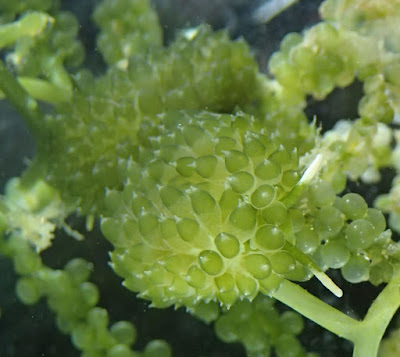 |
| Sacoproteus smaragdinus (Baba 1949),
Krug, Wong, Medina, Gosliner & Valdés, 2018
DOI: 10.1111/zsc.12310
|
Abstract
“Cryptic” can refer to species that match their background through camouflage or disruptive colouration, or in taxonomy to externally similar but unrecognized congeners. In adaptive resemblance, organisms resemble parts of a larger host animal or plant on which the mimic is highly cryptic. Mimetic lineages that radiate onto superficially similar hosts may contain cryptic species in both senses: taxa that are difficult to detect, and challenging for taxonomists to distinguish. Here, we describe a new genus and four species of herbivorous sea slugs (Gastropoda, Heterobranchia, Sacoglossa), including remarkable mimics of toxic green algae (Caulerpa spp.) on which the slugs feed. The long‐recognized Stiliger smaragdinus Baba 1949 is highly mimetic of “sea grapes” (Caulerpa racemosa‐lentillifera), but phylogenetic analyses of four genes indicated Stiliger was polyphyletic: the name‐bearing species grouped within Placida, whereas Caulerpa‐mimetic lineages were phylogenetically distinct. We erect the genus Sacoproteus gen. n. for S. smaragdinus (Baba 1949), and describe four new species: Sacoproteus nishae sp. n. from the Indo‐Pacific, which mimics Caulerpa chemnitzia; Sacoproteus yhiae sp. n. and Sacoproteus browni sp. n. from southern Australia, which mimic Caulerpa cactoides and Caulerpa gemminata; and Sacoproteus thomasleei sp. n., a non‐mimetic west Pacific species that shared key features. Stiliger s.s. and Placida species show crypsis and aposematism but not host mimicry, although Stiliger spp. feeding on undefended algae may be Batesian mimics. Investigating the ecology and biogeography of Sacoproteus gen. n. will yield insight into how selection generates such extraordinary examples of adaptive resemblance in the marine realm.
KEYWORDS: aposematism, coevolution, cryptic species, heterobranch, mimicry, phylogenetic systematics
 |
| From their torpedo-like shape to their white tips, the bulbs on Sacoproteus smaragdinus's back look just like the sea grapes of Caulerpa lentillifera. |
Sacoproteus gen. n.
We erect the genus Sacoproteus gen. n. for S. smaragdinus (Baba 1949),
four new species:
Sacoproteus nishae sp. n. from the Indo‐Pacific, which mimics Caulerpa chemnitzia
Sacoproteus yhiae sp. n. and Sacoproteus browni sp. n. from southern Australia, which mimic Caulerpa cactoides and Caulerpa gemminata
Sacoproteus thomasleei sp. n., a non‐mimetic west Pacific species that shared key features.
 |
| Sacoproteus nishae's mushroom-shaped bulbs let it blend in perfectly with the algae Caulerpa chemnitzia. |
Patrick J. Krug, Nur Leena W. S. Wong, Melanie R. Medina, Terrence M. Gosliner and Ángel A. Valdés. 2018. Cryptic Speciation yields Remarkable Mimics: A New Genus of Sea Slugs that Masquerade as Toxic Algae (Caulerpa spp.). Zoologica Scripta. DOI: 10.1111/zsc.12310
Stunning new sea slug species look just like seaweed
on.natgeo.com/2QUin8y via @NatGeo




